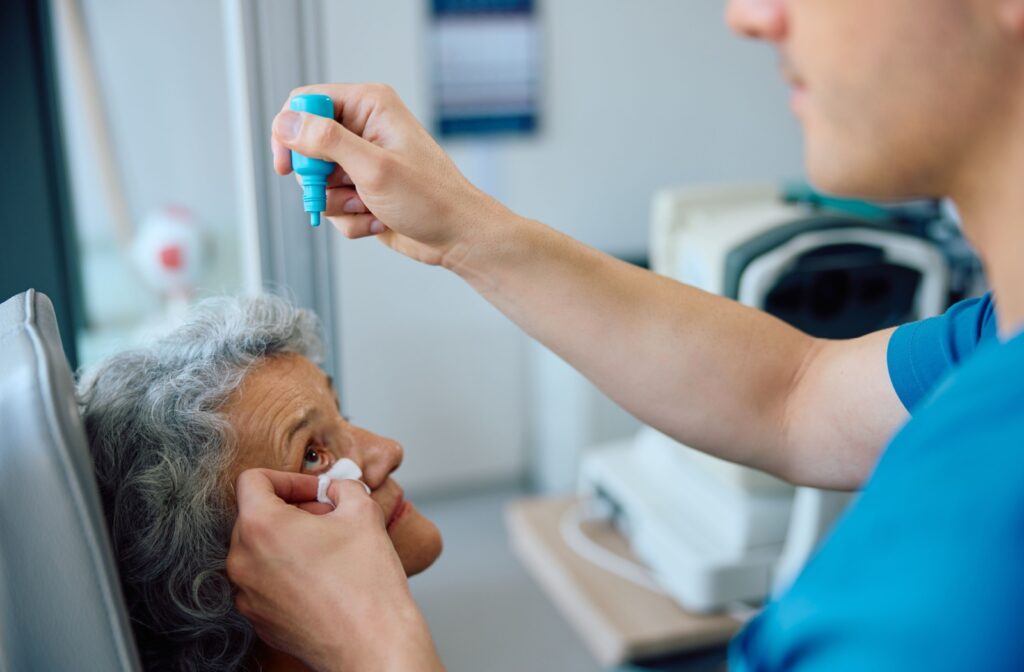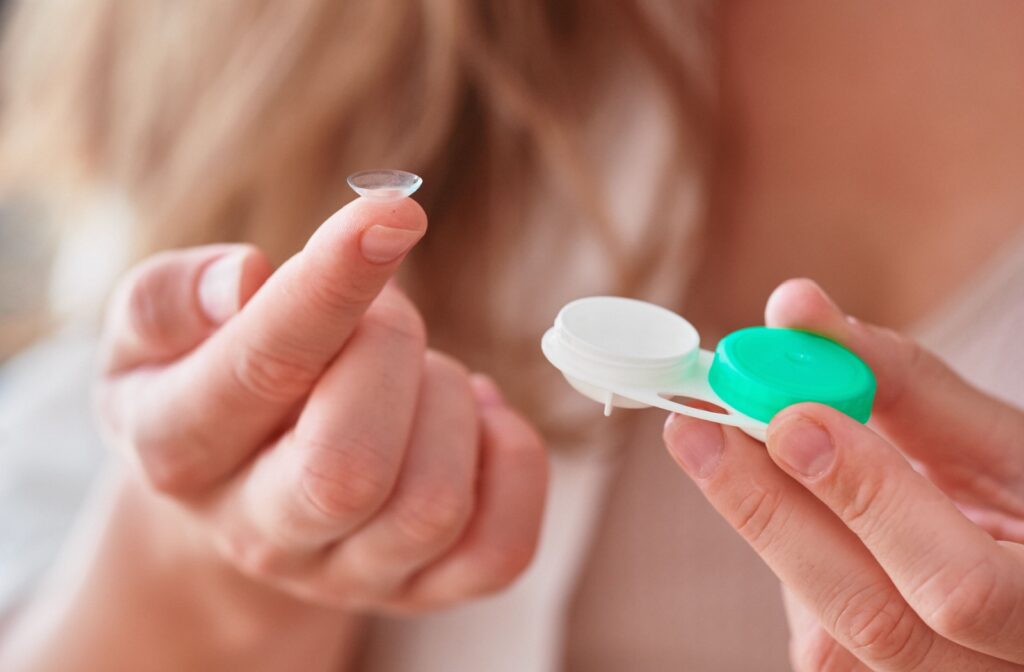A dilated eye exam offers valuable insights into your overall eye health. It’s normal to experience side effects afterwards, such as blurry vision and light sensitivity, for about 4 to 6 hours.
While you technically can wear contact lenses with dilated pupils, we do not recommend it. Here are some of the reasons why:
- The sensitivity can lead to greater discomfort
- Dilating eye drops directly interact with the eye’s surface
- Blurry vision can be a concern
- Safety first
Erring on the side of caution is always the smart choice. Wait for your vision to return to normal (which can take 4 to 6 hours) before wearing your contact lenses.
What Happens During Pupil Dilation?
Although not everyone requires it, pupil dilation can be part of a routine eye exam. This process involves using specialty eye drops to make your pupils wider (or dilated). This allows more light to enter the eye and provides a clearer, more detailed view of the retina, optic nerve, and other internal structures of the eye.
However, while pupil dilation allows for a closer look at your eye, it does have a few drawbacks, like temporarily affecting vision. Here’s what you might notice during and after dilation:
- Blurry vision, particularly with close-up objects.
- Increased sensitivity to light (because more light is entering your eyes).
- Difficulty focusing on small details.
- Eyes that may feel slightly dry or irritated because of the drops themselves.
These side effects often last between 4 and 6 hours, but may last longer if the formulation of the eye drops involved is strong or if you have lighter colored eyes.
Simply put, a dilated eye exam provides clearer retinal images, such as OCT scans and fundus photos, making it easier for your optometrist to identify any potential concerns.
Contacts & Dilated Eyes: What You Should Know
Many people prefer wearing contact lenses to their routine eye exams, however, we don’t recommend wearing them immediately after dilation.
Here’s a closer look at why:
Sensitivity Can Cause Discomfort
During and after dilation, your eyes are extremely sensitive.
The entire purpose of this test is to allow more light to enter your eye (hence the pupil enlargement), which can lead to greater light sensitivity that amplifies irritation or discomfort when wearing contact lenses.
Given that your eyes may already feel dry or slightly “off” following dilation, adding contact lenses to the equation can make this worse.
Dilating Drops Interact with the Eye Surface
Eye drops interact directly with the eye, leaving a thin residue on the cornea. Similarly, contact lenses correct vision by resting comfortably on the cornea.
As such, inserting your contact lenses too soon can trap the residue between the lens and your eye, causing potential irritation.
Reduced Vision May Be a Concern
When your pupils are dilated, your vision becomes temporarily blurry, especially for close-up tasks
Though many people rely on their contact lenses for vision correction, contacts won’t resolve the blurriness that stems from dilation. Neither will your eyeglasses.
This is largely why wearing your contact lenses is unnecessary and also inconvenient.
Safety First
Dilated pupils make your eyes less responsive to changes in light, leaving you vulnerable to discomfort in bright or sunny conditions.
Contact lenses don’t provide UV or light-blocking protection (unless specially designed to), so it’s safer to use sunglasses with solid sun protection post-dilation rather than layering on contact lenses.

When Can You Safely Wear Contacts After Dilation?
For most people, the side effects of pupil dilation wear off within a few hours. Once your pupils return to their normal size and your eyes feel comfortable again, it’s safe to resume contact lens wear.
Here’s a general timeline that might be useful to follow:
- Wait 4 to 6 hours: Allow enough time for the dilating drops to wear off completely and for your vision and light sensitivity to return to normal.
- Check for comfort: Before putting your lenses back in, check that your eyes feel normal (i.e., no lingering dryness, irritation, or sensitivity to light).
Caring for Your Eyes After Dilation
Wearing contacts is just one of many things to consider after dilation.
Here are some helpful ways you can keep your eyes comfortable and protected while you wait for the effects to wear off:
- Wear sunglasses: Dilation makes your eyes more sensitive to bright lights, including the sun. Bring sunglasses with UV protection to your appointment. This helps reduce discomfort and protects your eyes from sun damage.
- Do not drive: Unless your vision has returned to a comfortable level, do not drive until dilation has worn off. Arrange for someone to drive you home or use a ride-sharing service.
- Rest your eyes: Give your eyes a break and avoid spending extensive time on screens or reading small print until your vision sharpens again. Digital screens and bright lights can exacerbate discomfort.
- Use artificial tears: If your eyes feel dry or irritated, preservative-free artificial tears can provide relief. Keep them handy in case you experience any lingering discomfort after your appointment.
Most importantly, adhere to your eye doctor’s instructions. Their advice can help you experience a smooth recovery from dilation.
Make Comfort a Priority
The thought of slipping your contact lenses back into your eyes might be tempting immediately after a dilated eye exam. But waiting until your vision and eyes return to normal is always better.
If you’re unsure when to resume wearing your contacts, it’s always better to err on the side and wait. If blurry vision or light sensitivity continues beyond 6 hours, check in with your optometrist. While it’s rare, some people can experience prolonged dilation effects.
If you have more questions about dilation or contact lens care, or if it’s time for your routine eye exam, connect with Total Vision Riverside Optometry and book an appointment. Our expert team is here to provide clear answers and expert care every step of the way.



